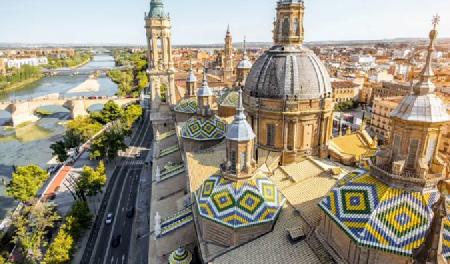Zaragoza
 Zaragoza, the capital of the Spanish region of Aragon, is recognized by tourists and residents as one of the most beautiful parts of Spain. It is fascinating with its magical atmosphere created by the colorful bouquet of historical and architectural masterpieces that have brought together the cultures of different countries and centuries .
Zaragoza, the capital of the Spanish region of Aragon, is recognized by tourists and residents as one of the most beautiful parts of Spain. It is fascinating with its magical atmosphere created by the colorful bouquet of historical and architectural masterpieces that have brought together the cultures of different countries and centuries .
Zaragoza's history dates back to the Romans, who called this settlement Cesarausta. From those times there was the Roman Forum in front of the Cathedral of La Seo, as well as part of the wall (3rd century AD) on Avenida César Augusto. The next historical stage took place in 714 after the Muslims took Zaragoza and settled here for four centuries. It was a period of cultural addition and flourishing that gave rise to the wonderful Aljafería Palace. Muslims, Jews, and Christians lived in peace, creating Mudejar-style island towers until the Inquisition.
By becoming the capital of Aragon, Zaragoza continued to develop, but half of the population died during the siege of the city by Napoleon's army in 1808-1809.
The picturesque Plaza del Pilar:
This is considered the heart of the Old Town, because it is a true admiration of tourists for the collection of historical and architectural treasures. Created in the 16th century on the site of an old cemetery, the square has evolved over the centuries into the cultural center of the Aragonese capital, becoming the most visited place by tourists and citizens. Almost all the main places of interest in Zaragoza are concentrated near the Plaza del Pilar. The majestic construction of the Cathedral of San Salvador (La Seo) has given a place of honor here.
The Seo Cathedral:
The majestic Seo Cathedral is a visual representation of the fusion of elements of Arab and European culture. Originally a Romanesque church, it was later rebuilt by the Arab conquerors into a mosque, which was again converted to a Christian cathedral after liberation.
Over the centuries, the church has acquired elements of Baroque, Gothic and Classicist architecture. Today, the white stone facade surprises with a richly decorated three-tier pediment facing the sky. The interior of the temple delights in luxury decorated with gold, frescoes and ceilings with stucco vaults and walls, colonnades, altars and chapels made by prominent Spanish masters. Most visitors are drawn to the black and gold chapel of San Marcos. In the treasury of San Salvador you will see a collection of priceless statues, paintings, and tapestries. The atmosphere of wonder can be felt under the vaults of this religious monument, a UNESCO World Heritage Site.
Museum of the Caesaraugusta Forum:
Near the Ceu Cathedral is the Caesaraugusta Forum Museum, located in ancient times on the site of the cathedral. Founded by the ancient Romans before Christ, the city was originally named in honor of César Augusto. Roman genealogy is evidenced by fragments of the ruins of an ancient Roman forum and buildings discovered during excavations. They were united in a museum that consisted of the ruins of the forum, the theater, the port and the theater. Near each of the remaining fragments is a photograph with the original view of the structure. By visiting the museum exhibition, you will be mentally transported to the ancient Roman era, where the line between myths and reality has blurred.
The Aljafería Palace:
The Aljafería Palace is the best Muslim masterpiece outside of Andalusia, near the Plaza Ciudadanía. The palace, which on the outside is reminiscent of a medieval fortress with round towers, on the inside is decorated in a Moorish, pedantic and skillful way - arches, filigree carvings, quotes from the Koran, Mudejar-style ceilings and a pleasant geometric garden in the courtyard.
Roman theatre:
It was once one of the most beautiful Roman theaters in Spain, the stones of which were later used in other buildings. It was not until 1970 that the theater was discovered, but part of it is still hidden, as it is under the Church of the Sacred Heart and the museum (Via San Jorge). The Zaragoza Museum is located 400 m south of the Roman Theater. It is dedicated to archaeological finds from prehistory to the Arabs, with 15 paintings and many Goya engravings on display.
Alfonso Street:
Alfonso street is the main pedestrian street in Zaragoza and is located in the historic center of the city, near Plaza del Pilar. The street stands out for its beautiful historical buildings, its modern fashion stores, its small tourist shops and its cozy atmosphere cafes. This landmark in Zaragoza is not a unique object, but this street definitely has its charm.

